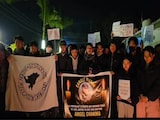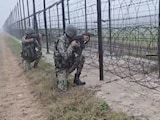British World War II veterans visit the war cemetery of Ranville, northwestern France, on June 4, 2014.
Bayeux, France:
"It's wonderful as an old man of 91 - it's like coming home."
As he was pushed in his wheelchair through the white grave stones of the Commonwealth war cemetery in Bayeux, Australian Bob Cowper was transported seven decades back in time.
Returning to Normandy for the first time since taking part in the D-Day invasion, the former night fighter pilot found his mind flooding with bittersweet memories of flying over the landing beaches on June 6, 1944.
At the end of a day when, in Barack Obama's words, "blood soaked the water and bombs broke the sky," Cowper and a Royal Australian Air Force comrade climbed into their Mosquito fighter plane and headed for northern France.
Their mission was to spot German aircraft and ensure they could not target Allied ground troops advancing from the beaches below.
"We shot down quite a lot of German bombers, and all the ones we shot down were big bombers carrying radio controlled bombs, so I think we made a good contribution," Cowper told AFP as he waited for Britain's Queen Elizabeth II to arrive at the cemetery.
"We saw all the build-up in the day. The sea was covered with ships, and there was a roaring of the planes in the air.
"Looking down, even though we were making a contribution, I remember feeling empathy for all the poor buggers fighting on the ground."
Bedecked in a lime green coat and matching hat, Queen Elizabeth joined her son Prince Charles shortly afterwards for a solemn tribute to those "poor buggers."
- 'We will remember them' -
Standing between Charles and French Prime Minister Manuel Valls, the monarch appeared lost in her own recollections as a veteran recited the Ode of Remembrance in front of the memorial to the 1,800 Commonwealth troops known to have died in Normandy who have no graves.
"They shall grow not old, as we that are left grow old.
Age shall not weary them, nor the years condemn.
At the going down of the sun and in the morning, we will remember them."
Charles saluted as The Last Post was played and then it was time for a moment of silence during which the representatives of some 50 veterans organisations held up their standards.
The ceremony concluded with wreaths being laid by, among others Australian Prime Minister Tony Abott and New Zealand Governor General Jerry Mateparaeheir.
In keeping with the warm tone of the proceedings, whatever security was in place was extremely discreet. As the queen and Prince Philip walked slowly out of the cemetery they were surrounded by members of the public, most of them brandishing smartphones.
The queen, 88, and her 92-year-old husband are trimming back their public engagements and had opted to start her day at the cemetery, leaving Charles to represent her at an earlier service in Bayeux cathedral.
British veteran Ken Godfrey, a year her senior, managed to attend both events, even opting to walk the mile (1.6km) from the cathedral to the cemetery that is home to more than 4,600 graves of soldiers from 11 countries, including 466 from Germany.
Setting off at a brisk pace, he kept it up despite the steep incline.
As he walked, his medals clinking, hundreds of people lining the route applauded him, shouting out "Thank you", "Bravo", and "Merci".
He smiled, saluted and applauded back before taking one woman's hand and giving it a gallant kiss.
Godfrey was with 49th West Riding Infantry Division and arrived in Normandy shortly after D-Day.
"My main memory is wading through the sea with water up to my chest," he told AFP. "But I don't like to talk about the fighting. If people ask, I just say we had a hairy time. But I'm lucky that I survived."
As he was pushed in his wheelchair through the white grave stones of the Commonwealth war cemetery in Bayeux, Australian Bob Cowper was transported seven decades back in time.
Returning to Normandy for the first time since taking part in the D-Day invasion, the former night fighter pilot found his mind flooding with bittersweet memories of flying over the landing beaches on June 6, 1944.
At the end of a day when, in Barack Obama's words, "blood soaked the water and bombs broke the sky," Cowper and a Royal Australian Air Force comrade climbed into their Mosquito fighter plane and headed for northern France.
Their mission was to spot German aircraft and ensure they could not target Allied ground troops advancing from the beaches below.
"We shot down quite a lot of German bombers, and all the ones we shot down were big bombers carrying radio controlled bombs, so I think we made a good contribution," Cowper told AFP as he waited for Britain's Queen Elizabeth II to arrive at the cemetery.
"We saw all the build-up in the day. The sea was covered with ships, and there was a roaring of the planes in the air.
"Looking down, even though we were making a contribution, I remember feeling empathy for all the poor buggers fighting on the ground."
Bedecked in a lime green coat and matching hat, Queen Elizabeth joined her son Prince Charles shortly afterwards for a solemn tribute to those "poor buggers."
- 'We will remember them' -
Standing between Charles and French Prime Minister Manuel Valls, the monarch appeared lost in her own recollections as a veteran recited the Ode of Remembrance in front of the memorial to the 1,800 Commonwealth troops known to have died in Normandy who have no graves.
"They shall grow not old, as we that are left grow old.
Age shall not weary them, nor the years condemn.
At the going down of the sun and in the morning, we will remember them."
Charles saluted as The Last Post was played and then it was time for a moment of silence during which the representatives of some 50 veterans organisations held up their standards.
The ceremony concluded with wreaths being laid by, among others Australian Prime Minister Tony Abott and New Zealand Governor General Jerry Mateparaeheir.
In keeping with the warm tone of the proceedings, whatever security was in place was extremely discreet. As the queen and Prince Philip walked slowly out of the cemetery they were surrounded by members of the public, most of them brandishing smartphones.
The queen, 88, and her 92-year-old husband are trimming back their public engagements and had opted to start her day at the cemetery, leaving Charles to represent her at an earlier service in Bayeux cathedral.
British veteran Ken Godfrey, a year her senior, managed to attend both events, even opting to walk the mile (1.6km) from the cathedral to the cemetery that is home to more than 4,600 graves of soldiers from 11 countries, including 466 from Germany.
Setting off at a brisk pace, he kept it up despite the steep incline.
As he walked, his medals clinking, hundreds of people lining the route applauded him, shouting out "Thank you", "Bravo", and "Merci".
He smiled, saluted and applauded back before taking one woman's hand and giving it a gallant kiss.
Godfrey was with 49th West Riding Infantry Division and arrived in Normandy shortly after D-Day.
"My main memory is wading through the sea with water up to my chest," he told AFP. "But I don't like to talk about the fighting. If people ask, I just say we had a hairy time. But I'm lucky that I survived."















